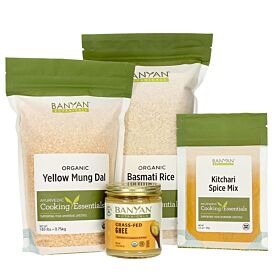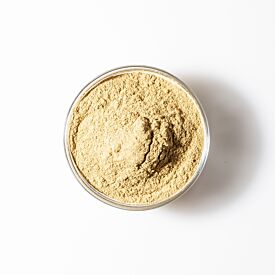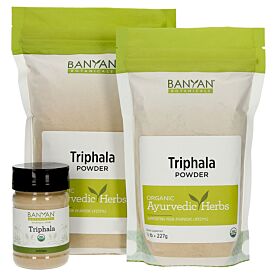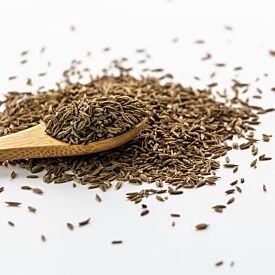An Easy Way To Cleanse at Home
Fall is such a special time—a season in itself, but also the transition between summer and winter. The shift is palpable. The air gets crisper, the temperature drops, and the leaves on the trees change color.
In Ayurveda, this change is a time for us to let go of what is no longer needed, to cleanse, and prepare for the coming season. What has been left undigested, creating toxicity, or ama, in your life? What are you ready to release, to cleanse, and to let go?
An Ayurvedic cleanse is a way for us to release ama which is not only undigested material or toxins in our physical body, but also emotional and mental clutter. Taking the time to cleanse can benefit us in body, mind, and spirit.
Traditionally, it is recommended to try a complete panchakarma treatment. However, this is a longer, stronger cleansing procedure, which is recommended to do in a clinic or Ayurvedic hospital. If you have the opportunity, go for it! But for the rest of us, let’s explore options we can easily practice at home.

Gentle At-Home Cleanse
This short cleanse and digestive reset is easily integrated into daily life. It offers simple techniques you can incorporate into your regular routine to support you during the change of seasons.
Remember to prepare gently. Fall is vata season and any sudden change will increase vata even further.
In an Ayurvedic panchakarma procedure, the preparation stage is called purvakarma—a time to encourage the body to let go of toxins and to eliminate. Traditionally this would be done with daily steam baths and oil massages. We, as householders in our normal day-to-day living, will modify this practice.
Oil Inside Out
Start to include more oil. Practice daily abhyanga (self-massage), and add oil or ghee to your meals. The oil and ghee help to soften the dhatus (tissues of the body). This in turn softens any ama and brings it out either through the skin or into the digestive tract where it can easily be eliminated.
Stoke the Fire
Kindle your agni (digestive fire). Our health is dependent on how we digest, transform, absorb, and eliminate. Taking care of our agni is the benchmark for health and well-being. Start adding digestive herbs and spices to your meals. Herbs such as cumin, coriander, fresh ginger, and fennel have dipana (enkindling the digestive fire) or amapacana (removing ama) qualities.
You can also make a digestive tea such as Cumin, Coriander, Fennel Tea:
1 quart of water
1–2 teaspoons whole cumin seed
1–2 teaspoons whole coriander seed
1–2 teaspoons whole fennel seed
Place all the ingredients in a pot, bring to a boil, reduce heat, and simmer for fifteen minutes, or until the seeds begin to sink. Remove from heat and strain. Drink it warm.
“It is obvious that the bodily tissues cannot be nourished and developed when food is not properly digested by the digestive fire”
Ready to Cleanse?
Now that we have started to oil up our body, directing ama to the digestive tract and stoking our agni, we are ready to eliminate and let go of the ama. One way to support this process is through a mono diet of kitchari. Try it for just one to three days. In Ayurveda, we recommend kitchari because it is a complete protein, it is nourishing, tridoshic, and very simple to digest. Even the most sensitive digestive system can cope with kitchari. It gives our body a rest. Kitchari is so easy to digest that our agni can start to eliminate any undigested material, or ama. Basically, it offers our body time to rest, digest, and reset.
There are many recipes for kitchari and you can even get a Cleanse Bundle with all the ingredients you'll need. But here is a recipe to get you started:
Kitchari Recipe
For one person, expect to use half a cup of rice per meal.
1 part Yellow Mung Dal
2 part Basmati Rice (or other grain)
4–5 parts of water (more or less water according to your preferences)
½ tablespoon Kitchari Spice Mix or ¼ teaspoon each of turmeric powder, ginger (preferably fresh), roasted cumin powder, and coriander powder.
Combine all ingredients in a pot. Bring to a boil, lower the heat, and simmer for 30–45 minutes until cooked.
Add 1 teaspoon of ghee, (or vegetable oil) at the end.
After you have completed your cleanse, you can add seasonal vegetables like spinach, peas, asparagus, or carrots, to make it a nourishing meal.
Enjoy the kitchari for breakfast, lunch, and dinner. Don’t snack, as your digestive system needs the time to fully digest. Instead sip warm herbal teas to support your digestion.
Cleansing Inside Out
One of the most popular Ayurvedic herbal combinations is Triphala, and it is excellent to take while cleansing. Triphala is tridoshic—a mixture of amalaki, bibhitaki, and haritaki—and is used to support digestion, elimination, and removal of excess dosha from the body.
During the internal cleanse, allow the mind to rest too. Take time to simply be. Sit in meditation, enjoy a warm relaxed bath, and spend a more time on your abhyanga.
Create an At-Home Ayurvedic Treatment
Warm up your abhyanga oil and massage it into your body with love, care, and compassion. Pay special attention to your abdomen and joints. Leave the oil on for twenty minutes while meditating. Then run a warm bath. Think of the bath as the svedhana (sweating) part of your Ayurvedic treatment. Sweating is another way to encourage the detoxing and cleansing effect on the body. If you are fortunate to have a steam bath or sauna at home or close by, this is the perfect time to utilize it.
Cleanse the Mind—Unplug and Meditate
Much of our ama is not just accumulated through our diet. It also comes from the sensory stimulation and overload we get from reading the news, being on social media, writing emails, and general stress. Take time to switch off the computer, the phone, and the television. Walk in nature, sit in meditation, or simply daydream. Taking time to be still and digest sensory overload is just as important as cleanseing the digestive system.












